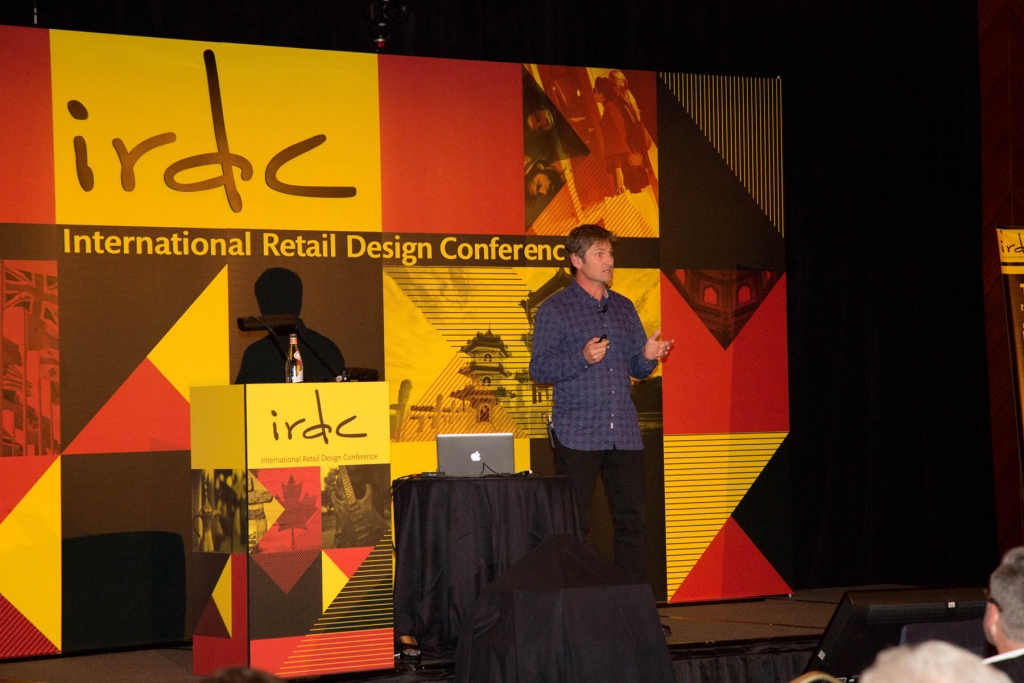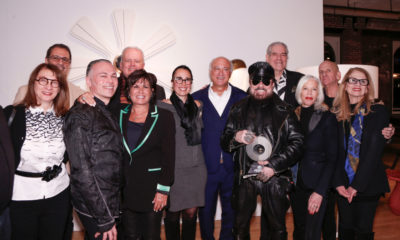Retailers coming to figure out how to reinvent themselves after four years of a stagnant economy got the blessing of not one but two powerful and relevant case studies at the 13th annual International Retail Design Conference (September 17-19 in Vancouver).
Keynote addresses by representatives from Starbucks and Sephora showed how two of the 90s’ most high-flying brands emerged from similar problems – primarily too much growth too soon, which stunted their momentum and operational efficiencies and ultimately the strength of their brands – to reengineer their paths to success.
Additionally, this year’s IRDC was back to its usual energy as one of the largest crowds ever filled the Four Seasons Vancouver’s meeting rooms, common areas and the Yew bar and restaurant for three days. (Plus the closing night party at Vancouver’s The Queen’s Republic club on Granville Street.)
The event got off to a rousing start as big air walls were retracted to reveal the cages and mannequins of this year’s Iron Merchant competition. Fortified by a festive signature cocktail and tasty eats, attendees cheered the teams on. Six highly competitive, spirited groups outfitted their display windows according to the theme, “What does the Canadian Mountie do at night after a long day at work?”
The Iron Merchant secret ingredient: a disco ball.
But then the conference got down to the serious business it’s well-known for. Here’s a recap of the conference highlights, and you can visit irdconline.com or check #IRDC2013 on Twitter for quotes, additional reviews and photos, or to learn about next year’s event, slated for September 2014, in Miami.
Advertisement
For more photos of IRDC, check out “Vancouver Vanguards.”
REINVENTION GRANDE
For Starbucks, it was the growing pains it experienced prior to and after the Great Recession that prompted its explosion of creative growth, said Bill Sleeth, vp of design for the Americas at Starbucks Coffee Co., on hand to receive VMSD’s 2013 Peter Glen Retailer of the Year award.
He described how Starbucks once again became one of the world’s most engaging brands by phasing out its cookie cutter 90s-era design template, characterized by the ubiquitous “four purple chairs” clustered in storefronts and other standard elements. Its fresh and innovative designs have a strong emphasis on localization.
In fact, Sleeth elicited “oohs” and “aahs” from the audience when he projected breathtaking photos of progressive, unique new installations in Mumbai, Amsterdam, Paris and China that showcased custom finishes, artwork, lighting and furnishings intended to foster deeper connections to neighborhood customers.
“It sounds weird, but we’re really trying to do mass customizations,” Sleeth said. These designs “tell the story of our coffee-growing regions using local artists and craftsmen.”
A commitment to sustainability is another priority for the Starbucks design team, which comprises 300 designers spread across the globe in 18 regional studios. “If we don’t do our part, we won’t have a product to sell,” Sleeth said.
Advertisement
THE BEAUTY EXPERT IS BACK
Sephora, too, got a little ahead of itself after its innovative breakthrough in the late 90s captivated the American market.
Paul Loux, the retailer’s svp, store design and property development, described a period of “sephoria,” defined by Allure magazine as “the elation one experiences when faced with an open sell of beauty products.”
But Sephora, which became known early for the introduction of so many new and exciting but unfamiliar beauty brands – a fortuitous accident, said Loux, “because the department store brands wanted to have nothing to do with us” – became somewhat of a commodity brand itself, opening 53 stores in its first two years in the U.S.
Loux talked about the renovation of the retailer’s store design, to make Sephora the beauty consultation expert once again, following that with a strong omni-channel effort to relate to shoppers through its website, Facebook, Twitter and other social media, encouraging shoppers to voice their opinions, participate in Sephora’s loyalty program and relate their experiences while interacting with the retailer’s well-trained beauty consultants.
“We tried to imagine what our customer’s digital day was like,” Loux said, “from checking social media in the morning with her coffee, to having a makeover during lunch and putting it on Instagram, to chatting with friends at night about what they’ve seen. We’ve tried to turn all those points of contact into drivers into the store, dissolving the barriers between digital and physical.”
STORES ARE NOT DEAD
Doug Stephens, Toronto-based futurist and author, began the conference by reassuring attendees that “stores are not dead.”
Advertisement
In fact, he said, “we’re entering the golden age of retail. We’re getting back to the magic and the craft, where the idea is to knock people’s socks off.”
Stephens acknowledged that we’re at the end of an era, “when you had to go somewhere to get something.” He said it’s less today about going and taking, more about going and thinking.
“Why go to the store unless there’s some experiential reason to do so,” he said. “You’re trying to create converts for your brand – ‘my mind is blown, I love these guys, I’d buy from them wherever they are’ – to create an emotional and physical bond with the customer.”
TAKING IT OVERSEAS
Peter Dixon, senior partner and creative director at Prophet Brand Strategy (New York), closed IRDC 2013 by showing how easy it is for retailers and designers to succeed when expanding abroad – and how easy to fail, too.
From placing the cheapest products closest to the ground in Germany (where customers expect the most inexpensive items at eye-level) to trying to ship thousands of gallons paint to China (it’s illegal), to ignoring such basics as local holiday schedules, material availability and availability of local partners, there’s much to get wrong.
Retailers as large and successful as Walmart have failed to adequately understand local traditions, habits and preferences when expanding abroad. For example, retail greeters in Germany were met with suspicion rather than warmth, and extended shopping hours ignored Germans’ avoidance of shopping at off hours.
Best Buy, in turn, failed to account for Chinese consumers’ propensity for haggling and deep discounting when it expanded. Hallmark faltered in France by failing to note the French preference for handwritten cards without saccharine messages.
When it comes to planning new stores internationally, Dixon said, pre-planning can save hundreds of thousands of dollars of waste and years spent analyzing failing retail spaces.
BREAKOUT SESSIONS
Amazon Can’t Do That. “The younger a person is in a store, the harder it is to impress her,” said Lee Peterson, executive vp of creative services for WD Partners, sharing exclusive survey results from a consumer study.
Millennials crave authentic interactions, Peterson said. In the study, they ranked shopping with friends and family as high in appeal. “People are inherently social,” Peterson said. “They don’t prefer to shop online, but if your store looks like a warehouse, why wouldn’t they just buy online.”
So don’t be boring, don’t be horizontal, don’t be conservative and don’t be terrifying, Peterson implored, and empower customer service. “The retail crime of the century is associates who don’t know anything about anything,” Peterson said.
For more detailed findings from WD Partners’ study, turn to page 48.
New Ideas from the Old World. John Ryan, VMSD’s European Editor, began his session by showing – with a giant QR code – how often in-store technology is “redundant and complete rubbish.” He urged participants to use such tech flourishes only out of necessity: “If you want tech in your stores, you need staff to help the shopper use it.”
Ryan demonstrated the rebirth of European supermarkets, as these venues move away from general merchandise. He pointed, for example, to high-end soft shops, like the upscale Euphorium Bakery, now set within Tesco grocery stores.
And as much as consumers and retailers alike have mourned the disappearance of some favorite shops, Ryan said the economic downturn has helped cull the current crop of stores, and encouraged survivors to stay sharp with well-maintained spaces. Even off-price retailers, such as Primark, have taken steps to present low-cost items in an upscale way.
Technology-Rich Experiences. “We have the building blocks,” said Florin Gale, Microsoft’s senior user experience manager, “but every store has its own unique recipe.”
Gale was part of a panel that also included Yahav Ran, ceo and co-founder of The Hive, an interactive agency in Bellevue, Wash., and Irwin Miller and Alan Robles of Gensler.
Microsoft’s implementation of an average of 84 video screens per store was a feat, from its physical design to the content it relays. Ultimately, said Gale, the goal is to fabricate an emotional experience instead of alienating customers with the store’s technology.
Gale said “content is king,” but Gensler’s Robles joked, “We were able to create store context to support your wonderful content.”
Brands, Brains and Buying. Architect and retail designer David Kepron, creative director of retail brand experience for Little (Charlotte, N.C.), explained how our brains “go” shopping and the affect of the in-store experience.
For example, humans are wired for empathic connection, with the brain being the social organ, said Kepron, whose new book, Retail (r)Evolution, will be released next year by ST Media Group’s book division. Thus, much like the old saying “monkey see, monkey do,” Kepron believes, “humans see, humans feel.”
Essentially, mirror neurons (the same thing that causes you to yawn when others yawn) can alter your customers’ moods depending on the emotional state of your employees. Lesson: You must have happy sales associates to foster happy visitors.
Kepron also explained how an in-store experience, such as a sale, causes prefrontal cortex excitement in the brain; and how unpredictable rewards or gifts create a positive, exciting experience for shoppers. “Stores give us a context of who we are,” he said. “In a strange way, it’s a cosmological experience outside ourselves.”
Retail Remastered. A panel of Cincinnati-based retail designers advised attendees to educate clients about taking informed risks that help make retail gratifying and exciting for shoppers.
Robyn Novak and Monica Gerhardt of FRCH Design Worldwide, Valerie Jacobs of LPK Trends and Bink Zengel of Luxottica pointed to services such as Domino’s step-by-step tracking app for pizzas as they’re cooked; watches packaged with notes hand-signed by a watchmaker; and Burberry’s immersive, participatory events for customers, often simulcast between stores in various cities – as a virtual fashion show – complete with champagne service.
Merchandise that can be personalized and/or customized, such as custom Burberry coats, helps create a memorable experience. But, said Novak, it raises new questions, too, such as “how much customization is acceptable to a brand?”
And when customization isn’t available, a local touch can revitalize chains. Zengel said PetSmart brought local animal rescue agencies in-store. In general, she credited smaller retailers with driving this demand. “Smaller companies are forced to be innovative, and this keeps bigger retailers on their toes.”
For more photos of IRDC, check out “Vancouver Vanguards” on vmsd.com.
THANKS TO OUR SPONSORS
PRESENTING SPONSOR
Hans Boodt Mannequins
DIAMOND SPONSORS
Alpolic Materials
Fleetwood
Leggett & Platt SFG
Scala
EMERALD SPONSORS
Kawneer/Reynobond products of Alcoa
Amerlux
Architectural Systems Inc.
Chippenhook
D|Fab
Grottini Retail Environments
High Country Millwork
JPMA Global Inc.
Kingsmen
Mack Studios
Miller Zell
Mondo Mannequins
Opto Intl. Inc.
Pattison Sign Group Inc.
Riot Creative Imaging
Visplay Inc.
SUPPORTING SPONSORS
Almax Mannequins USA LLC
Alu Inc.
Grand Entrance
North American Signs
Pacific Northern Inc.
PD Instore
Prism Skylabs
Rodgers Wade Manufacturing
Rose Displays
Storefloors


 Photo Gallery7 days ago
Photo Gallery7 days ago
 Headlines6 days ago
Headlines6 days ago
 Headlines1 week ago
Headlines1 week ago
 Headlines2 weeks ago
Headlines2 weeks ago
 Headlines1 week ago
Headlines1 week ago
 Designer Dozen2 weeks ago
Designer Dozen2 weeks ago
 Special Reports2 weeks ago
Special Reports2 weeks ago
 Designer Dozen5 days ago
Designer Dozen5 days ago


















